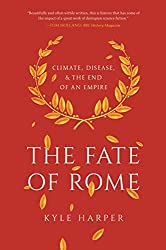
Rating: 8.3/10.
The Fate of Rome: Climate, Disease, and the End of an Empire by Kyle Harper
Book about the fall and decline of the Roman Empire. The decline of the Roman Empire can be analyzed from many angles: Officially, the Roman Empire was invaded by barbarians and the last emperor was in 476 AD, but the empire had been in decline for several hundred years before that. The main root causes were climate change and plagues at the time, which made the empire weak to foreign invasion.
The peak of the Roman Empire was around 168 AD, just before the Antonine plague. For the last several hundred years, it had seen a period of real growth, mostly due to favorable climatic conditions (“Roman Climatic Optimum”) that were optimal for agriculture. However, the climate started to change and North Africa became drier, leading to water and food shortages and pressuring the Roman government to divert resources from elsewhere. Around 170 AD, Rome was hit by the Antonine plague, the earliest pandemic in history. Believed to be a form of smallpox, it spread from east to west, reaching the whole empire in a few years and had around 15 to 20% mortality rate. It didn’t lead to societal collapse, but affected the economy greatly, and weakened the army.
The 3rd century saw a lot of political instability: after Marcus Aurelius, the last of the five “good emperors”, the empire had a secession of many emperors with roots from the military. The Cyprian plague was likely a form of Ebola-like virus, spread from North Africa. The Roman Empire had no way of dealing with disease; this is also when Christianity started to take hold – faced with deadly pandemics, many people took solace in a religion that promised eternal salvation in the afterlife.
Generally the cycle of events looks something like this: climate change leads to failed harvests and famine, weakening the immune system and allowing disease to take hold. Climate change also forces people (from beyond the borders) to migrate, causing of crowding in cities and the migration of people spreads disease. This cycle seems to be a destabilizing force throughout the wider region, as a plague or famine in any area would create pressures for neighboring areas. Emperor Constantine led a short period of recovery during the 4th century, but this was not to last. The army was weak and could not prevent an influx of migrants from Germanic areas. Unable to prevent foreigners from entering, Rome reluctantly allowed them to migrate into the empire, which later led to invasions. The last Western Roman Emperor was disposed in an invasion in 476 AD.
Still, worse was yet to come in the 6th century. Several different natural factors coincided so that the climate became much colder around the year 536 AD and a few decades afterwards. This led to mass starvation, and in 540 AD the Justinian plague hit the empire, wiping out approximately half of Europe population. This plague was caused by Yersinia pestis, the same microbe that caused the bubonic plague in the Middle Ages, in fact, it was the first time that this microbe had evolved to be harmful to humans, and instead of a single pandemic, it reemerged every generation or so for the next 200 years. Governments struggled to function, and to many living at the time, the world must have seemed to be coming to an end, an attitude which we have ample evidence in Christian writings.
Overall, a fascinating academic book about this period of several hundred years of history. The decline of the Roman Empire was a long process caused by several factors. The book places a lot of emphasis of climate change being the root cause of many bad events: favorable climatic conditions led to growth and prosperity, while cold and dry periods were associated with mass starvation, disease, and foreign invasions by people forced to migrate. Contrary to Malthusian theory, most population-level death events were due to disease, not hunger, although the two are somewhat connected as starving people are more likely to get sick. Definitely a relevant read for today, and a reminder that climate change and pandemics can end a great empire.



